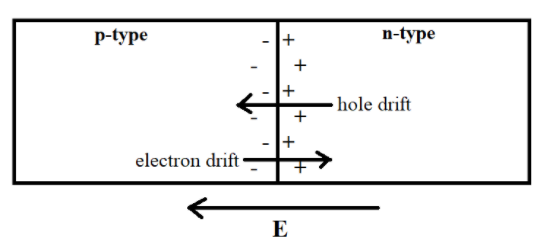
When $5V$ potential difference is applied across a wire length $0.1m$, the drift speed of electron is $2.5\times {{10}^{-4}}m{{s}^{-1}}$. If the electron density in the wire is $8\times {{10}^{28}}{{m}^{-3}}$, the resistivity of the material is closed to
$\text{A}\text{. }1.6\times {{10}^{-8}}\Omega m$
$\text{B}\text{. }1.6\times {{10}^{-7}}\Omega m$
$\text{C}\text{. }1.6\times {{10}^{-6}}\Omega m$
$\text{D}\text{. }1.6\times {{10}^{-5}}\Omega m$
Answer
588k+ views
Hint: Resistivity of a material can be calculated using the relation between electron density in a conductor and its resistivity. We will use Ohm’s law to find the value of resistivity of the given material.
Formula used:
$J=ne{{V}_{d}}$
$\begin{align}
& n\text{ = free electron density} \\
& {{V}_{d}}\text{ = drift velocity} \\
\end{align}$
Complete step by step answer:
In the microscopic view of Ohm’s law, it is observed that an applied electric field superimposes a small drift velocity on the free electrons in a metal conductor. This drift velocity is in the order of millimeters per second.

Drift velocity is described as the average velocity acquired by the charged particles, such as electrons, in a material due to the presence of an electric field. We can say that an electron in a conductor will propagate randomly at the velocity equal to Fermi velocity, resulting in an average velocity zero.
The current density, electric current per unit area $J=\dfrac{I}{A}$, can be expressed in the terms of free electron density as:
$J=ne{{V}_{d}}$
$\begin{align}
& n\text{ = free electron density} \\
& {{V}_{d}}\text{ = drift velocity} \\
\end{align}$
With the help of Ohm’s law and expression for resistivity, we have
$I=\dfrac{V}{R}$, and$R=\dfrac{\rho L}{A}$
It gives,
$\begin{align}
& J=\dfrac{V}{RA}=\dfrac{V}{\dfrac{\rho L}{A}A}=\dfrac{EL}{\rho L}=\dfrac{E}{\rho }=\sigma E \\
& J=\sigma E \\
\end{align}$
We are given the value of potential difference, length of wire, drift speed and electron density. We have to find the value of resistivity of material.
$\begin{align}
& {{V}_{d}}=25\times {{10}^{-4}}m{{s}^{-1}} \\
& n=8\times {{10}^{28}} \\
\end{align}$
We know that,$J=ne{{V}_{d}}$, and, $I=ne{{V}_{d}}A$
Also,
$\dfrac{V}{R}=ne{{V}_{d}}A$
Or, $\dfrac{V}{\dfrac{\rho L}{A}}=ne{{V}_{d}}A$
$\dfrac{V}{\rho L}=ne{{V}_{d}}$
$\rho =\dfrac{V}{ne{{V}_{d}}L}$
Putting values, we get,
$\rho =\dfrac{5}{8\times {{10}^{28}}\times 16\times {{10}^{-19}}\times 25\times {{10}^{-4}}\times 0.1}$
$\rho =1.6\times {{10}^{-7}}\Omega m$
Hence, the correct option is B.
Note: While performing the calculations in the above question, keep in mind the SI units of all the terms you are using while solving the question. Do not get confused between Diffusion current and Drift current. Diffusion current in a semiconductor is caused by the diffusion of charge carriers while drift current is caused due to the motion of charge carriers by the force exerted on them in the presence of an electric field.
Formula used:
$J=ne{{V}_{d}}$
$\begin{align}
& n\text{ = free electron density} \\
& {{V}_{d}}\text{ = drift velocity} \\
\end{align}$
Complete step by step answer:
In the microscopic view of Ohm’s law, it is observed that an applied electric field superimposes a small drift velocity on the free electrons in a metal conductor. This drift velocity is in the order of millimeters per second.

Drift velocity is described as the average velocity acquired by the charged particles, such as electrons, in a material due to the presence of an electric field. We can say that an electron in a conductor will propagate randomly at the velocity equal to Fermi velocity, resulting in an average velocity zero.
The current density, electric current per unit area $J=\dfrac{I}{A}$, can be expressed in the terms of free electron density as:
$J=ne{{V}_{d}}$
$\begin{align}
& n\text{ = free electron density} \\
& {{V}_{d}}\text{ = drift velocity} \\
\end{align}$
With the help of Ohm’s law and expression for resistivity, we have
$I=\dfrac{V}{R}$, and$R=\dfrac{\rho L}{A}$
It gives,
$\begin{align}
& J=\dfrac{V}{RA}=\dfrac{V}{\dfrac{\rho L}{A}A}=\dfrac{EL}{\rho L}=\dfrac{E}{\rho }=\sigma E \\
& J=\sigma E \\
\end{align}$
We are given the value of potential difference, length of wire, drift speed and electron density. We have to find the value of resistivity of material.
$\begin{align}
& {{V}_{d}}=25\times {{10}^{-4}}m{{s}^{-1}} \\
& n=8\times {{10}^{28}} \\
\end{align}$
We know that,$J=ne{{V}_{d}}$, and, $I=ne{{V}_{d}}A$
Also,
$\dfrac{V}{R}=ne{{V}_{d}}A$
Or, $\dfrac{V}{\dfrac{\rho L}{A}}=ne{{V}_{d}}A$
$\dfrac{V}{\rho L}=ne{{V}_{d}}$
$\rho =\dfrac{V}{ne{{V}_{d}}L}$
Putting values, we get,
$\rho =\dfrac{5}{8\times {{10}^{28}}\times 16\times {{10}^{-19}}\times 25\times {{10}^{-4}}\times 0.1}$
$\rho =1.6\times {{10}^{-7}}\Omega m$
Hence, the correct option is B.
Note: While performing the calculations in the above question, keep in mind the SI units of all the terms you are using while solving the question. Do not get confused between Diffusion current and Drift current. Diffusion current in a semiconductor is caused by the diffusion of charge carriers while drift current is caused due to the motion of charge carriers by the force exerted on them in the presence of an electric field.
Recently Updated Pages
Master Class 12 English: Engaging Questions & Answers for Success

Master Class 12 Economics: Engaging Questions & Answers for Success

Master Class 12 Social Science: Engaging Questions & Answers for Success

Master Class 12 Maths: Engaging Questions & Answers for Success

Master Class 12 Chemistry: Engaging Questions & Answers for Success

Master Class 12 Business Studies: Engaging Questions & Answers for Success

Trending doubts
What are the major means of transport Explain each class 12 social science CBSE

Which are the Top 10 Largest Countries of the World?

Draw a labelled sketch of the human eye class 12 physics CBSE

Explain sex determination in humans with line diag class 12 biology CBSE

The pH of the pancreatic juice is A 64 B 86 C 120 D class 12 biology CBSE

Explain sex determination in humans with the help of class 12 biology CBSE




